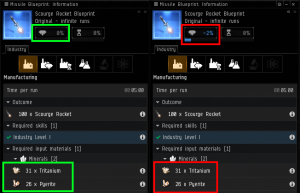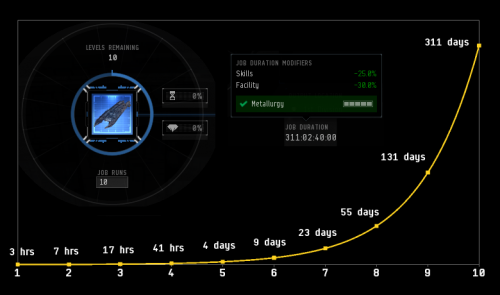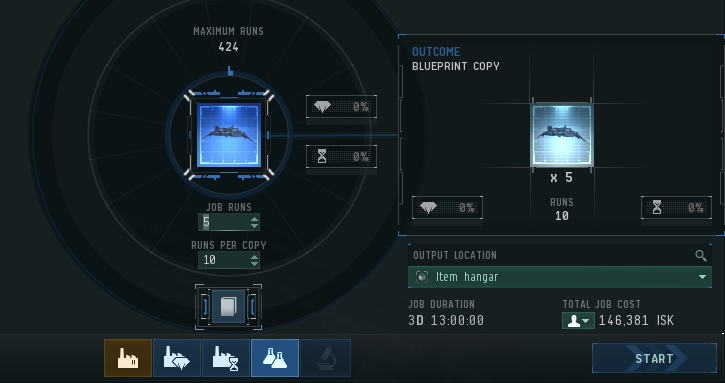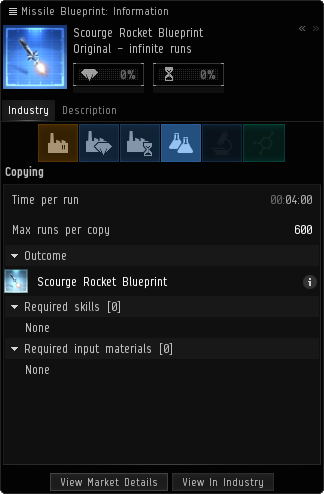| Industry Portal |
|---|
| Production |
| Resource Collection |
| Trade |
| Other |
| Other Resources |
Research is the process of improving a Blueprint Original (BPO). Two types of research are performed: Material Efficiency research and Time Efficiency research, also known as ME and TE. Material Efficiency research decreases the number of materials required for the production of the blueprint, whilst Time Efficiency research decreases the production time of the item produced.
Research may also involve blueprint copying, which produces Blueprint Copies (BPC). As the blueprint is researched and copied, the ME and TE levels of the original blueprint will be transferred onto the blueprint copy.
Skills
None of these skills are actually required for any research. However, they will all make your research operations far easier and quicker and are very worthwhile training if you intend to do a lot of research.
- Science (1x) - reduces the time required to copy a BPO by 5% per level
'Science is the basic skill in the Science section of the character skills. This skill will reduce the time required for blueprint copying by 25% at maximum level. This skill is also the prerequisite for almost all the other skills in the science section.
- Advanced Industry (3x) - reduces all manufacturing and research times by 3% per level
This skill will reduce the time required for manufacturing and research by 15% at maximum level. Requires Industry III.
- Research (1x) - reduces the time required for Time Efficiency research, by 5% per level
This skill will reduce the time required for TE research by 25% at maximum level. Requires Science III.
- Metallurgy (3x) - reduces the time required for Material Efficiency research, by 5% per level
This skill will reduce the time required for ME research by 25% at maximum level. Requires Science IV.
- Laboratory Operation (1x) - allows you to perform one additional research or copying job per level
Every character starts off with the ability to run a single research or copying job without needing to train this skill. Laboratory Operation gives you an extra research/copying slot for each level trained: if you train it to V, you can run 6 research or copying jobs at once. Requires Science III.
- Advanced Laboratory Operation (8x) - allows you to perform further additional research or copy jobs per level
Once you have trained Laboratory Operation to V, you can then train this skill to increase still further the number of concurrent research or copying jobs you can perform to a maximum of 11 jobs.
- Scientific Networking (3x) - allows you to start research jobs at range, without needing to be in the same system with the facility.
Requires Laboratory Operation IV. Without training this skill, you can start jobs anywhere in the current system. Each level in this skill gives you the ability to start research jobs an extra 5 jumps away to the maximum of 25 jumps at level V (this may include other regions).
Other helpful skills:
- Cybernetics (3x) - allows the use of implants.
The Zainou 'Beancounter' line of implants boost research & copying speeds. A dedicated researching character would benefit greatly from one or more of these implants.
Material Efficiency Research


Material Efficiency (ME) research reduces the number of materials required to manufacture the item from the BPO. It can clearly be seen that the fewer materials you require to build an item, the more profitable selling your item is likely to be. New BPOs bought from the market will have an ME of 0%, but you can often find BPO sellers in contracts or on the Sell Orders forum, that will sell you pre-researched BPOs (or BPCs) for your manufacturing business. You can also find blueprints ingame through contracts.
The current ME level of a blueprint can be seen by looking at the info on a blueprint, or by opening the Industry window and browsing your blueprints. Each time you perform ME research on a BPO, it will reduce the materials required by -1%. You can do ME research 10 times in total, for a total reduction of -10% on the materials required. Though blueprint copies with higher ME can be received as a reward from COSMOS missions.
Materials will always round up to the next whole number, so you will never need 23.75 units of tritanium to build a module, for example, or you will never need 0.75 Atrons to build an Ares.
It is important to note that material rounding happens after you have multiplied by the number of runs. Here's an example, the Scourge Rocket BPO. You can see that at 0% ME, the Scourge rocket requires 31 Tritanium and 26 Pyerite to build. If you researched it to 2% ME, it would require 30.38 Tritanium and 25.48 Pyerite. Because minerals round up, if you only did a single run to build a single batch of rockets, the amount of materials required would not actually change.
However, if you did 100 runs to build 100 batches of rockets because material rounding occurs after you multiply by the number of runs, you would need 3038 Tritanium and 2548 Pyerite to build 100 rocket batches. In this way, even researching to -1% or -2% ME can be worthwhile if you intend to mass produce items.
However, no required materials can be reduced to less than one per run. If your 0% ME blueprint requires 1 unit of a material to build, even ME -10% will not reduce that amount of materials at all. This is most obvious in T2 ship manufacturing where you will always need one T1 hull for one T2 product even with high ME and multiple runs. For example, you will always need 10 Rifters to build 10 Jaguars, never 9, even if your Jaguar blueprint is fully researched.
Time Efficiency Research
Time Efficiency (TE) research reduces the amount of time required to manufacture the item from the blueprint. It can be seen that the faster you can build an item, and thus re-use your production slots for more items, the more profitable your business is likely to be. New BPOs bought from the market will have a TE of 0%, but you can often find BPO sellers in contracts or on the Sell Orders forum, that will sell you pre-researched BPOs (or BPCs) for your manufacturing business. You can also find blueprints ingame through contracts.
The current TE level of a blueprint can be seen by looking at the info on a blueprint, or by opening the Industry window and browsing your blueprints. Each time you perform TE research on a BPO, it will reduce the time required by 2%. You can do TE research 10 times in total, for a total reduction of -20% in manufacturing time required.

How long does research take?
ME and TE research both take the same time to perform. The duration depends on the rank of the blueprint and the current research level.
Note that ME and TE levels and research duration are counted separately. So improving the ME level will not have any effect on how long TE research will take.
All BPOs have a Rank (not visible in-game) which determines how long they take to research. Rank 1 blueprint is the "baseline" blueprint. The table below shows the research times needed for a baseline blueprint.

| Research Level | Seconds | Approximate Time |
|---|---|---|
| 1 | 105 | 1m 45s |
| 2 | 250 | 4m |
| 3 | 595 | 10m |
| 4 | 1,414 | 24m |
| 5 | 3,360 | 56m |
| 6 | 8,000 | 2hr |
| 7 | 19,000 | 5hr |
| 8 | 45,255 | 12hr |
| 9 | 107,700 | 1 day |
| 10 | 256,000 | 3 days |
Research times for blueprints of higher rank are simply base duration multiplied by the blueprint rank.
The table below shows the blueprint ranks for various blueprint groups.
(Note that while T2 categories are listed below for completeness, T2 BPO's are no longer obtainable and T2 BPC's cannot be researched.)
| Rank | Items |
|---|---|
| 1 | All T1 small ammo, T1 small drones T1 mining crystals |
| 1.6 | All T2 small ammo, T2 mining crystals |
| 2 | All T1 medium ammo, T1 medium drones, subsystems |
| 3 | All T1 large ammo, T1 large drones, T1 lowslot/frigate modules, fuel blocks |
| 3.2 | T2 medium ammo |
| 4 | T1 capital ammo, capital T2 components |
| 4.8 | T2 large ammo |
| 5 | T2 small drones, T1 small rigs |
| 6 | T1 medium/cruiser modules |
| 7 | T1 deep core/strip/ice miners |
| 7.8 | T2 small/frigate modules |
| 9 | T1 large modules |
| 10 | T2 medium drones, T1 medium rigs |
| 12 | T1 Warfare links |
| 15 | T2 large drones, proto cloaks, T1 large rigs |
| 15.6 | T2 med/cruiser modules |
| 18.2 | T2 strip/deep core/ice miners |
| 20 | T1 frigates, T1 capital rigs |
| 23.4 | T2 high/battleship modules |
| 30 | T1 destroyers |
| 31.2 | T2 warfare links, Improved cloaks |
| 39 | Covops cloaks |
| 40 | T1 cruisers, fighters/bombers |
| 50 | T1 battlecruisers, T2 small rigs |
| 60 | T1 battleships, capital components |
| 80 | Old-style POS Arrays |
| 100 | Medium T2 rigs, Old-style POS Small Control Towers |
| 120 | T1 Capital High-slot modules |
| 150 | T2 large rigs |
| 180 | Special-purpose Capital modules (e.g. Clone Bay) |
| 200 | Non-super capitals, Old-style POS Medium Control Towers, Upwell station components Customs Office, Territorial Claim Unit, Old-style Outposts, Rorqual and Orca. |
| 240 | Capital Doomsday Weapons |
| 300 | Old-style POS Large Towers |
| 312 | T2 Capital Tractor Beam/Remote Cap Transmitter |
| 400 | Supercarriers, T2 frigates, Infrastructure Hub |
| 468 | T2 siege/triage |
| 600 | Titans, T2 destroyers |
| 800 | T2 cruisers |
| 1000 | T2 battlecruisers |
| 1200 | T2 battleships |
| 4000 | Jump freighters |
For example Carriers and Dreadnought BPOs are rank 200, giving them a time to research to ME from 0% to 1%: 105 seconds × rank 200' = 21,000 seconds, or 5hr 50m. In general, the bigger or more expensive a thing is, the higher rank its BPO is, and the longer it takes to research.
The cost of research
Installing research jobs is not free. Installing a ME or TE job will have the following cost:
- ,
where Process Time Value is a number derived from the material cost of producing the item, blueprint rank and blueprint research level (ME and TE handled separately) and the system cost index is a number derived from the amount of work done in that system.
The system cost index is calculated as
The process time value for researching from level n-1 to level n is calculated as
where the base durationn is the job duration of researching a rank 1 blueprint to level n in seconds as listed in the above table for base research times. The sum term is usually very close to the price estimation of the raw materials of the blueprint but the exact value can only be found from ESI /markets/prices/ endpoint.
In case where you are researching an unresearched blueprint to level n the process time value is slightly simpler
You will additionally need to pay the facility tax which is
Copying
Copying a blueprint original produces a number of blueprint copies with a specific number of runs. For example, in the image below we have chosen a Blackbird BPO, requested 5 runs, and each resulting copy would have 10 runs. The final output would produce 5 BPCs with 10 runs each, from which you could build 50 total Blackbirds.
Once you have used up all the runs on a BPC, it is destroyed (you simply won't get it back after the last manufacturing run). You cannot research BPCs, so make sure your BPO is researched to the ME and TE levels you require before you copy it.
Different BPCs have a different maximum number of runs you can set. Ship BPCs for example can only be given 10 runs, whereas most modules and ammunition can have up to 600 runs. You can see the maximum runs per copy in the information of a BPO.
How long does copying take?
As well as the maximum runs per copy, you can also see the base copy time - a.k.a. time per run - in the information of a BPO.
Copying of a BPO always takes 80% of the build time, on a per run basis. Note that this is before applying bonuses for skills and POS facilities - because manufacturing and copying have different skills & facilities affecting their duration, your personal copy time may not be exactly 80% of your personal build time. Copy time is also NOT affected by the level of TE on the BPO. For example, small ammunition and drones, and basic modules, typically take 5 minutes to build and thus will take 4 minutes to copy.
This base copy time is then multiplied by the number of runs and the runs per copy value. Or, in other words, the total duration of your copy job is the base copy time, times the number of items you could build with the output copies. For example, whether you want five 10-run copies or ten 5-run copies, the total copy time would be 50 times the base copy time.
The cost of copying
The cost of copying a BPO is
where the system cost index is calculated in the same way as it was for researching but with work hours done on copying jobs.
Surprisingly for both invention and copying the Material Adjusted price is still based on the Manufacturing inputs of the final item. If you copy a Damage Control I blueprint for example, you need to calculate the EIV based on the manufacturing inputs for a Damage Control I module. While for invention it will be based on the manufacturing inputs for the T2 item itself.
Why should I copy my BPOs?
- Security
- Well-researched BPOs take a lot of time to produce, especially for bigger ships such as capitals. Putting your BPO in a POS - for a facility reduction in materials and time - makes it vulnerable to attack. For this reason, you can first copy the BPO, and then take only the BPC out to the POS for manufacturing, leaving your BPOs safely in station.
- In-corp security can also be increased using BPCs. If you don't trust your corp mates with your BPOs, you can instead keep a personal copy line running and release frequent BPCs for corp usage.
- Invention
- Creating a Tech 2 BPC can only be done using a Tech 1 BPC - not a BPO. This process is called invention and requires a T1 BPC of the item you wish to invent (for example, if you want to invent a 425mm Autocannon II, you need a BPC for a 425 Autocannon I).
- Multiple manufacturing jobs
- You can only run a single manufacturing job at a time from a BPO. Using the BPO to create multiple BPCs, and then manufacturing from those BPCs instead, can increase your productivity.
- Copying as a business
- Selling well-researched BPCs, for other manufacturers to build from, can be a lucrative business in itself.


